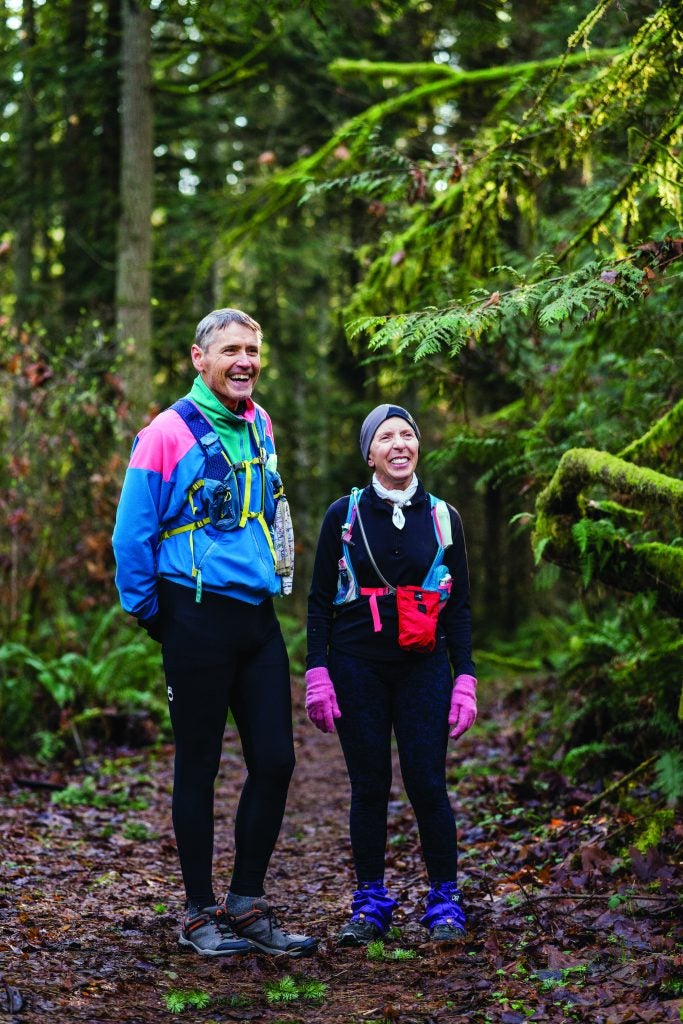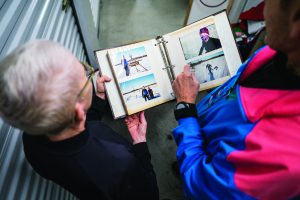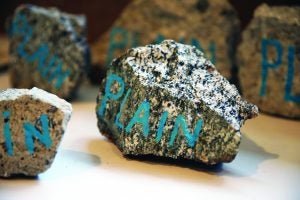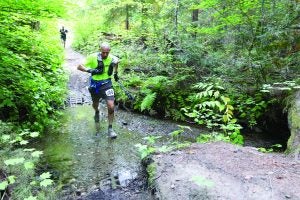New perk! Get after it with local recommendations just for you. Discover nearby events, routes out your door, and hidden gems when you sign up for the Local Running Drop.
“Into the dark you all must go. Where you’ll stop, nobody knows.” It’s 4:59 a.m., and, on a dirt road in the middle of nowhere, Tim Dehnhoff is reading a poem. Several dozen runners stand listening, their swirls of breath illuminated in headlamp beams in the cold morning air.
He continues: “It’s always darkest before the sun’s rise. Success is in the journey; finishing not the only prize.”
It’s been 20 years since Dehnhoff nearly lost his life in a rappelling accident. At the time, he’d been a competitive runner, triathlete and climber who’d recently run the Leadville Trail 100. He was a member of his local search and rescue (SAR) chapter. While practicing some newly acquired rigging skills, he’d misjudged his rope length in a rappel off a tree and fell 30 feet before slamming into the ground. The impact severed his spinal cord. Doctors told him he’d never walk again.
“You obviously don’t know me well,” he’d replied. While in the hospital, he spent as much time as he could in the gym, working his body. The nurses would kick him out at 2 a.m. and send him back to his room to rest.
His hard work paid off. With the aid of canes, he learned to walk again and, over the next two decades, would assist with several hundred SAR missions. Not long after the accident, local SAR leader Dave Smith and race directors Christina “Chris” Ralph and Tom Ripley invited him to help lead SAR efforts at their newly minted Plain Endurance Run in the Entiat Mountains outside of Plain, Washington.

“It was very therapeutic for me after my accident,” says Dehnhoff. “For years, I took support from others. Now I get to give it. I owe a lot to Tom, Chris and Dave for sucking me into this.”
At this year’s start line, he wraps up the ceremonial reading of the Plain poem, which he penned a decade ago: “Your will to finish is all so clear. By or before 5 p.m. on Sunday, we expect to see you right back here. … OK, you all have about three seconds.” He pauses, then says, “Go”—and, with that, the runners set off into the dark.
In the mid-1990s, ultrarunners and adventure partners Ralph and Ripley began making annual pilgrimages to Alaska. There, they competed in extreme endurance races like the Iditasport and the Yukon Arctic Ultra, which involved hauling all their food and survival gear on sleds for 100-plus miles across snowy expanses. Enamored with the self-sufficiency that such races required, the two began scheming about a self-supported ultra back home in Washington State.


They envisioned a race with no course markings, no aid stations, no water drops, no T-shirts or medals or buckles. They’d write out detailed, turn-by-turn directions so runners wouldn’t necessarily even need to carry a map. Local SAR teams would man checkpoints along the way; they wouldn’t be permitted to offer runners aid or directions, but they’d help keep everyone safe. In return, the race would give them opportunities to practice their ham radio skills. It would also serve as a fundraiser, donating race proceeds to local SAR efforts.
The course Ralph and Ripley had in mind lay in the Entiat Mountains, near the unincorporated town of Plain. Using what ultrarunner Ray Gruenewald would later dub “Ripley’s Believe-It-or-Not Math,” the course comprised two different loops—the first roughly 100K (62 miles), and the second 45ish miles. It boasted some 21,000 feet of elevation gain through some classic central Washington country—chock-full of steep and dusty climbs, exposed ridgelines, thick pine forest, granite boulderfields, creeks, lakes and plenty of vistas of nearby jagged peaks. It would be the state’s first trail 100-miler.
When someone complained that the course was long, Ripley responded incredulously: “We give you 100 miles, plus a free 10K.”
They’d call the race Plain.
Whether with existential crises, nausea, blisters, sleep deprivation, hypothermia, heat stroke, sore muscles, tired bones or some combination thereof, the 100-mile distance knows how to break a person. Part friend, part foe, it delights in smashing egos, the way any outdoor athlete’s objective does—the alpinist’s mountain, the surfer’s wave, the climber’s project.
Plain has more riddles to solve than your run-of-the-mill hundred. There’s the navigational challenge of it, of course—the possibility of missing turns and doing bonus miles, then having only yourself to blame (and many long, lonely miles for self-flagellation). Though the race is on well-established trails with mostly marked intersections, that hasn’t prevented runners from getting spectacularly lost—most commonly around a campground called Goose Creek. In the dark of night and afflicted with “Plain Brain,” many have run in unwitting circles there for hours.

Even Tim Stroh, Plain’s only 10-time finisher, and Randy Gehrke, founder of Cascade Crest 100, running together, got disoriented one year. Stroh had recently begun wearing the new Montrail Leona Divide shoes. At some point, he noticed their distinctive tread pattern in the dirt ahead.
“Wow, check it out,” he said to Gehrke. “Someone else with Leona Divides!”
Then the men stopped and looked at each other. It dawned on them: the tracks were Stroh’s. Worse, it took them another hour to find their way out.
Accomplished Pacific Northwest ultrarunner Van Phan holds the record for the most female finishes (three). On a training run one year, she suspected that she, too, might be trapped in the Goose Creek vortex. She used a stick to write her name in the dirt. Ten minutes later, sure enough, she saw her name traced in the middle of the trail ahead.
“This race attracts only crazy people, then puts them in a situation where crazy stories are going to happen,” says James Varner, whose first 100-miler was Plain, before he went on to become a five-time Hardrock 100 finisher and prolific race director in the Pacific Northwest. In 2004, he led Plain for 87 miles before making a wrong turn and blowing his lead.
“If there are aliens observing us from above,” he says, “their favorite channel to watch is definitely the Plain channel.”
Chris Ralph first met Tom Ripley in 1991, while running on Tiger Mountain near Seattle with fellow ultrarunning pioneer, Lynn O’Malley. They spotted Ripley from afar, standing and pointing somewhere off into the hinterlands.
“He looked like that photo of Lewis and Clark,” Ralph remembers. “I said, ‘Now, there is a man who knows what he’s doing.’” She marched up to him and told him she needed to be his friend. It was the beginning of a lifelong friendship for the two, who are now in their late 60s.
As with many ultrarunners, both Ripley and Ralph came to the sport via the well-trodden path from addiction.
“We were all drunks back then,” says Ralph. “I was a four-pack-a-day smoker. Always had one in the ashtray, one behind my ear and one in my mouth that I was trying to light.”
She’d also been diagnosed with multiple sclerosis at the age of 27. She found that running helped her keep flare-ups at bay. When she finished her first marathon at age 36, wearing K-mart shoes, she could scarcely believe it when someone handed her a medal; there had been no sports for girls when she was growing up. She ran her first ultra several years later after watching a TV special about Western States.
Ripley also began running as a way to quit smoking and drinking. He started running road races in the mid 1970s. In 1983, he ran his first ultra—the old Falls to Gasworks 75K road race from Snoqualmie to Seattle. Back then, most ultras were on roads.
By the time the two met, Ralph was busy helping two other local ultrarunners, Ron Herzog and Ike Hessler, lay the groundwork for the state’s first real trail ultramarathon: the Granite Falls 50K (later renamed the Ron Herzog 50K after Herzog was diagnosed with ALS). A year later, she began gathering the permits to hold a 50-mile foot race near Crystal Mountain, on trails around the family cabin of another friend Greg Jacobson.
“Whether it was 50 miles or not, who knows?” Ralph says of that inaugural White River 50. “But it was damn hard. I said, ‘If it ain’t 50, it’s worth 50.’”
With Dave Smith’s help, Ralph founded a nonprofit, the Cascade Running Club. She and Ripley soon earned a reputation for putting on quirky events. Tom’s wife at the time, Linda, planned and prepared food at all the races. Their events raised money for everything from SAR to multiple-sclerosis research to Sparrow Clubs, a nonprofit inspired by Dameon Sharkey, the young son of Ralph’s first training partner.
Their races were cheap and scrappy. One year, the female champion at the Herzog 50K complained about not receiving a prize. To appease her, Ralph found a stale bagel in her car and used a Sharpie to write “1st Woman” on it.
In 1996, a heavy snow year, Steve Pierce got lost. He stumbled on a shed in the woods and rang the doorbell. It turned out to be a high-security U.S. Navy building. When asked why he was there, Pierce replied that he was doing a race.
“Where’s your bike?” they asked.
“I’m running,” he explained. No one believed him, so he was promptly hauled inside and strip searched.
Ripley and Ralph delight in such accounts of the “Type II fun” (rotten in the moment, but satisfying in retrospect) they’ve inflicted on runners. In 1994, a logging company dug 39 massive ditches in a two-mile stretch of the Herzog course. The “tank traps” soon morphed into overgrown, swampy pits of misery. As far as Ralph and Ripley were concerned, though, the traps only added to the race’s charm—so much so that they turned it into an out-and-back so runners had to crawl through the hellacious traps twice. They called it the Tanks A Lot 50K.
Ripley, a droll man with a perpetual glimmer of mischief in his eyes, says, “If it were up to me, I’d have everyone tie their legs together and run a three-legged 100.”
Once, while running up to Kendall Katwalk at night, he’d observed that his and his partners’ flashlights were superfluous. Though the trail was technical, the moonlight glinted luminously off the rocks around them. Ripley suggested they create a nighttime mountain race called “Bright or Not So Bright,” in which participants could opt to compete without lights.
Ralph, who was responsible for permits and insurance, vetoed the concept. It did, however, give rise to their first nighttime trail race, the Bridle Trails Twilight 8 Hour. And Ripley, true to form, went lightless whenever he ran it.
In Plain’s inaugural running in 1997, six runners toed the start line, including Ralph, Ripley and others who’d seen an ad for Plain in UltraRunning magazine. All six DNFed, stymied by heavy snow on Klone Peak just 20 miles in. At one point, Ralph fell into a creek and grew so cold she thought she might die.
“It was fabulous,” she recalls 20 years later, eyes twinkling.
In a race report distributed to the old ultrarunning listserv, Martin Miller of Montana referenced Tennessee’s famously brutal Barkley Marathons, directed by Lazarus “Laz” Lake: “[Tom] was very disappointed that things did not turn out as planned, but a 0-percent finishing rate (Is Laz green with envy?) is some consolation.”
In the coming years, Plain’s DNF rate settled in around 90 percent. While Plain often punished speedsters with bonus miles due to missed turns, its 36-hour time limit proved challenging for the slow-but-steady crowd. Miller, a two-time Hardrock finisher, would eventually claim a Plain record—eight DNFs to his name and zero finishes. His reasons for failure ranged from getting timed out to unwieldy blisters to Goose Creek woes. (After running around in circles for an hour, then being certain he’d gotten back on track, Miller had seen a flashlight coming toward him—Mike Burke of Portland, Oregon. Both men insisted the other was running the wrong way.)
“The Hardrock course is tougher,” says Miller, “but Hardrock’s 48-hour time limit makes it a slightly easier event than Plain.”
The only four people who managed to finish Plain in its first six years did so running in pairs—Tim Stroh and Randy Gehrke in 1998 and, in 2002, Montanans Liz McGoff (who had just broken the Cascade Crest 100 course record three weeks earlier) and her husband, Tom Hayes.
In his race report, Hayes wrote, “We were both practically in tears, promising ourselves we would never run again and would disown all our ultrarunning friends.”
They didn’t. In fact, a week later, back home in Montana, Hayes described feeling “a little homesick for Chris and Tom, their priceless SAR crew and the other runners who have developed ‘Plain Fever.’” He and McGoff created their own unmarked, unsupported, Plain-esque race outside of Bozeman: the Devil’s Backbone 50-Mile.
Most years at Plain, there’s nearly a 1:1 ratio of SAR volunteers to runners. Dehnhoff has long relished something Ripley once said to him: “I’ve run 136 ultras all over the world, and there’s no doubt: your support team is the best I’ve ever experienced.’”
The night before the race and the morning of, everyone enjoys a home-cooked meal together at Clear Creek Lodge. Each runner is issued a small rock with the word “PLAIN” hand-painted on it. (It’s not required to carry it during the race.) If the runner finishes, he or she exchanges it for a larger lump of granite that reads, “PLAIN 100.” In case of a DNF, the runner keeps the original “Plain rock” as a talisman of failure.
Martin Miller keeps his collection out in his yard, and every time he goes out to the garage and sees them, he says, “They kinda pour salt in the wound.” Tim Stroh, who amassed six DNFs on his way to his 10 finishes, refers to his Plain rocks as his “cone of shame.”
Plain’s comically long list of DNFs over the years is a veritable who’s who of veteran ultrarunners, all with impressive resumes. Take Hans Dieter-Weisshaar of Germany, an eight-time finisher of the Hardrock 100 who, at 73, finished five of the hardest 100-milers in a single summer—Hardrock, Leadville, Cascade Crest, Wasatch and the Bear. But in 2001, a spry 61 at the time, he couldn’t figure out how to finish Plain.
Then there was Dimitri Kieffer, the eccentric Frenchman who had traveled on foot across the Bering Strait with fellow adventurer Karl Bushby. Hauling 200-pound sleds behind them, they’d spent 14 days swimming across open water and trekking over jagged ice floes from Alaska to Siberia. (Upon arrival, they’d been arrested and detained for entering Russia illegally.) Despite multiple attempts, Kieffer never notched a Plain finish either. One year, he spent so long running around in circles in Whistling Pig Meadows that Ralph drove up into the hills to retrieve him.
Ripley couldn’t fathom it: “He’d get lost at Plain, and I’d say, ‘Dimitri, come on, give me at least a little bit of your potential!’”
But even Ripley and Ralph themselves, who’d completed everything from Marathon Des Sables to Susitna to the Coastal Challenge, couldn’t piece together their own jigsaw puzzle. They attempted Plain many times, but never with success: “I’d kill for a Plain 100 finish,” says Ripley.
“That’s what always stuck out to me,” says Dehnhoff. “Tom and Chris created such an evil race that even they couldn’t finish it.”
Another factor in Plain’s difficulty is its technical, unpleasant footing; the course primarily follows rutted-out dirt-biking singletrack. It’s often blanketed in fine dust that makes for wobbly landings and a gritty shoe interior. In the early years, the dust was nearly knee-deep in places. Since then, dirt bikers have laid cinderblock to tamp down the switchbacks into slightly more palatable pits of soft dust. The half-buried blocks of concrete, however, deliver their own challenges.
There’s also the need to carry a heavy pack, loaded with enough supplies for self-sufficiency in the mountains for 100-plus miles. It’s a gamble between carrying too much and not enough. A mistake on either side can spell the end of one’s race.
As Ray Gruenewald once wrote, “Plain punishes unpreparedness, inexperience, mistakes and just ‘plain’ bad luck.”
There are enough streams along the course that it’s possible to run most of it with a couple handheld bottles—gambling, too, between stopping to filter and drinking straight from the source. (At the prerace briefing, Dehnhoff quips, “The beauty of giardia is that it doesn’t show up for a week, and you’ll be done with the race by then, we hope.”) The one exception is the 14-mile dry stretch after leaving Tommy Creek. Ripley has always claimed you can stomp around in the meadows up on Tyee Ridge and find water in the ground. Most folks don’t believe in Ripley’s phantom water sources, though, so opt to carry a gallon or more on that stretch. It’s a cruel joke that the race’s biggest, most exposed climb—some 5,000 feet in six miles to the top of the ridge—must be done in the heat of the day while carrying eight to 10 pounds of water, in addition to the rest of one’s gear.
That said, having taken Ripley at his word, runner Pat Ackley ran out of water one year atop the ridge and managed to find a puddle of swamp water to lap from. Later, he reported, “Mosquito larvae and ferns never tasted so good.”
Over time, runners got smarter. They learned to train on the course beforehand, or find a veteran partner to team up with. They lightened their packs; gone were the days of hauling pounds of flashlight batteries and replacement incandescent bulbs, as was necessary before LED headlamps became common. They began using GPS. (Ralph and Ripley’s thoughts on this: “Use whatever you want. Plain is hard enough.”) These days, the DNF rate has sunk to a more modest 50 percent.
In 2014, Ralph and Ripley added a 100K option, and in 2016, handed off the race reins to Stroh and Dehnhoff. “The Tims,” as they’re known, added a low-key aid station for 100-mile runners at the 100K mark, where they’ll cook you up a cheeseburger before you head out on the second loop. (In years past, crews were always permitted here; a makeshift aid station cropped up in some years, but runners never knew whether to expect it.)
Some things haven’t changed, though: Plain has no lottery, and, even in recent years, its 75 spots have never come close to filling up. Compared to other hundreds, it remains dirt cheap. And, every year, Goose Creek still finds a way to dash to pieces at least one runner’s dreams of finishing.
Plain is an event in which people get intimately acquainted with pain. There is something to be said for the lessons imparted by such arbitrary, self-inflicted suffering. After all, the more comfortable you get with adversity when you’ve deliberately invited it, the more strength you cultivate for when it might show up unbidden.
Ralph and Ripley both credit running—and the friendships they’ve formed through it—with helping them through difficult times, including their own medical struggles over the years. (Ripley was diagnosed with a brain tumor in the 1990s. After getting surgery to have it removed, he resumed running two days later.)
Tragedy has touched the lives of many of the old-guard members of “the Plain family” over the years. They lost Ron Herzog in 1996, Dameon Sharkey in 2001 and Dave Smith in 2011. In 2002, Scott McQueeney—a veteran ultrarunner of Badwater 135 and Western States 100 who’d scored a couple Plain DNFs in the early years—made a bet with his ailing 16-year-old daughter that she didn’t have cancer; if she did, he promised to run a marathon backwards.
When she was diagnosed with Burkitt’s lymphoma, he upheld his promise at the 2002 Portland Marathon. Though his daughter overcame cancer, Scott passed away six months later after suffering a heart arrhythmia at the finish line of a 50K. For years to come, many runners wore “McQ” buttons at Plain and other ultras throughout the Northwest, and ran the final steps of their races backwards in his honor.
At 3 p.m. on Sunday, in the same place from where the runners set off 34 hours earlier, someone yells, “There he is!”
There is a flurry of excitement at the sight of Plain rookie Mark Cliggett through the trees, making his way down the final stretch of trail before the finish line. He’s the final runner out on the course this year, following 17 fellow finishers and 16 DNFs. Along with a smattering of SAR folks, runners are strewn about in camp chairs, drinking beers, trading war stories and tending to blisters or sprained ankles.
Everyone cheers as Cliggett crosses a faint line traced in the dirt. Stroh and Dehnhoff award him hugs, handshakes and a cheeseburger.
Cliggett later summarized his experience: “It was inspiring to be around people willing to set off on this completely ridiculous adventure. … It was kind of like a family reunion for the Tribe of People with Very Poor Judgment.”
Even after 20 years, Plain remains a specimen of old-school ultrarunning at its finest. It invites a small cadre of masochists together once a year to share a stupidly hard endurance challenge in the mountains. It is a challenge in which absurdities are celebrated, and everyone feels like family by the end.
Since 2000, Dehnhoff has never missed Plain. However, this past year, he did not expect to make it to the race. His wife, Tammy, had been diagnosed with stage IV cancer and recently moved into hospice care. Leaving her behind for a weekend seemed unfathomable.
And yet, as Plain approached, Tammy insisted he go. She wanted her husband to have a respite, however brief, from the grief at home. She knew how much the race and the community around it had meant to him over the years.
“Thank, God, I went,” he says. “At the end of the day, memories are all you have, and mine are all good.”
—Yitka Winn is a writer in Seattle. Plain played rough this past year, but still won over her heart.
This article was originally published in the 2018 issue of Dirt.
